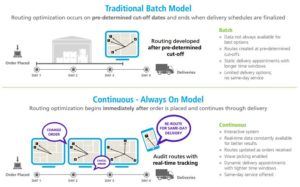Descartes: Commercial Logistics Optimization
“Here’s a math problem for you. Each United Parcel Service Inc. driver makes an average of 120 stops per day. There are 6,689,502,913,449,135,000,000,000,000,000,000,000,000,000, 000,000,000,000,000,000,000, 000,000,000,000,000,000,000,000,000,000,000,000,000, 000,000,000,000,000,000,000,000,000,000,000,000,000, 000,000,000,000,000,000,000,000,000,000,000,000,000,000,000,000,000,000,000 alternatives for ordering those stops. Which option is the most efficient…?"
“Here’s a math problem for you. Each United Parcel Service Inc. driver makes an average of 120 stops per day. There are 6,689,502,913,449,135,000,000,000,000,000,000,000,000,000,000,000,000,000,000,000,000,000,000,000,000,000,000,000,000,000,000,000,000,000,000,000,000,000,000,000,000,000,000,000,000,000,000,000,000,000,000,000,000,000,000,000,000,000,000,000,000,000,000,000,000,000 alternatives for ordering those stops. Which option is the most efficient, after considering variables such as special delivery times, road regulations, and the existence of private roads that don’t appear on a map?” [1]
In logistics businesses, route optimization sound like obvious lever for cost control, but how do companies execute on this while accounting for orders, customer preferences, and routing options that can change by the minute? While some large industry players like UPS have invested in developing proprietary technology to address these issues, a number of specialized businesses including Descartes have emerged over the last decade to help tackle logistics challenges. [2]
Descartes was founded back in 1981, but growth has accelerated meaningfully over the last decade, driven by a combination of acquisitions and organic growth. [3] Services have expanded from a long history of improving communication and information sharing within logistics businesses to include transportation management and regulatory compliance; but core offerings at the company today include routing, mobile, and telematics products, including electronic on-board recorder services (EOBR).
Commercial logistics optimization services today are no longer limited to route optimization, but also include dynamic re-optimization, inventory tracking, and driver safety monitoring. Descartes’ telematics products, including the EOBR devices, allow for fleet tracking, data displays with real-time information sharing capabilities, and integration into CRM and other back-end IT tools. [4] Selected benefits for Descartes’ customers include:
- Lower variable costs: Benefits from (1) real-time route distance optimization, which decreases daily vehicle miles driven and increases driver and truck utilization, lowering fuel costs per delivery and improving labor and asset productivity [5], (2) optimizing routes away from road hazards and construction zones which may be more likely to cause damage and need for maintenance capital expenditures, and (3) detailed fleet efficiency KPI reporting, including real-time fuel consumption and expense management, which allows for review and improvement
- Fleet size optimization: Improving utilization and productivity decreases the asset base (e.g., drivers and trucks) required to service the same amount of product
- Enhanced customer service: (1) Dynamic re-optimization allows for real-time delivery additions and order cancelations to be factored into routing to maximize efficiencies and (2) drivers are able to input notes and customer feedback for later review
- Improved driver and truck safety: (1) Driver metrics like active hours and idle time are monitored to ensure safety compliance, and driver safety scoring metrics include acceleration, speeding, hard breaking, and aggressive maneuvering to ensure that the driver maintains safe driving protocols at all times; (2) truck metrics include oil pressure, engine temperature, and door sensors (in addition to idle time, miles driven, etc.) to ensure that the asset is being properly used and maintained
While Decartes has established valuable and differentiated tools in the logistics optimization space, the company will need to continue increase the value of services to its customers and embed deeper into customer organizations to optimize their own positioning in the rapidly evolving logistics and transportation markets. Some service and product considerations might include:
- Expanding inventory management capabilities: Today, Descartes implicitly helps with inventory management at their customers’ (and their own) facilities by allowing for dynamic order changes and route prioritization, which can prevent a logistics-driven shortage in required inventory or excess inventory caused by dropping off an order cancelled in the same day. Descartes is well positioned to deepen relationships with their customers by offering vendor managed inventory solutions such as automated stock-out re-ordering (e.g., using a sensor or manual entry to link downstream customer inventory to supplier and logistics service providers)
- Strategic planning for the introduction of autonomous vehicles: Descartes should immediately explore potential partnership opportunities autonomous vehicle hardware and software developers; while deepening customer relationships by expanding services like inventory management may create some incremental customer stickiness, autonomous logistics vehicle software will likely be able to replicate much of the Decartes product offering in the longer-run unless the Descartes software or hardware can be integrated early on
- Increase smart city and smart fleet technology capabilities: The company has the opportunity to be on the forefront of smart fleet and smart city technology. As Descartes continues to grow its install base of EOBR sensors, it could serve as a central clearinghouse for commercial logistics route optimization across customers. This value could expand with data sharing with smart city grids with real time information sharing improving the route optimization capabilities for Descartes’ customers
In the near term, however, the company appears to be poised for continued success:
Exhibit 1: Descartes Revenue
(769 words)
Exhibit 2: Dynamic Route Optimization Overview
Sources:
[1] Steven Rosenbush and Laura Stevens, “At UPS, the Algorithm Is the Driver” http://www.wsj.com/articles/at-ups-the-algorithm-is-the-driver-1424136536 , accessed Nov. 2016
[2] UPS 2015 Annual Report http://nasdaqomx.mobular.net/nasdaqomx/7/3491/4988/, accessed Nov. 2016
[3] Descartes 2015 Investor Presentation https://www.descartes.com/content/users/gmuir%40descartes.com/investor_presentation_sep2016_final.pdf, accessed Nov. 2016
[4] Descartes Telematics Product Overview https://www.descartes.com/solutions/routing-mobile-telematics/telematics-compliance, accessed Nov. 2016
[5] Descartes Dynamic Route Optimization Overview https://www.descartes.com/wp-content/uploads/continuous_route_optimization.pdf, accessed Nov. 2016





Super interesting blog post! Do you think that Descartes main competitive advantage lies in its underlying software algorithm or its strategy for commercializing that software algorithm to customers? Or maybe other competitors have the potential to create similar products but are disadvantaged by Descartes’ first mover advantage? Just curious how unique the underlying technology is to this company.